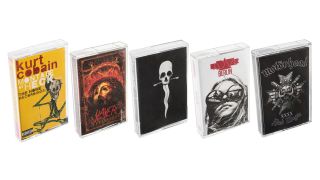This year’s rock fans have gone back to the using the reel thing.
With vinyl firmly back on the musical agenda, the gatekeepers of cool are already digging the next retro format out of the dustbin of history: the cassette. This year, new albums from Slayer, Motörhead and Sweat Lodge have been released on cassette, as have high-profile reissues from artists including Nirvana (the soundtrack from the new documentary Montage Of Heck) and Metallica, whose 1982 demo No Life ’Til Leather was reissued as part of Record Store Day, complete with lovingly reproduced handwritten scrawls.

“It’s a fun item to offer to people,” says Christoph ‘Tiger’ Bartelt, drummer with German retro-metallers Kadaver, whose most recent album, Berlin, was released on cassette. “I like that they’re these small, nostalgic items. And because my car’s pretty old I have a tape deck, so that’s what I listen to when I’m driving.”
Even during the cassette’s heyday in the 1980s it was still the poor relation to vinyl; when the compact disc arrived it was largely forgotten. But cassette culture never truly died, with diehards favouring its analogue warmth and pocket-sized portability. Ironically its recent resurgence is in part a reaction to the renewed popularity of vinyl, which itself was a reaction to the rise of MP3s and streaming.
“They had this novelty aspect, because people were mostly into buying vinyl,” says Bartelt. “And the visual side is definitely part of the attraction – I know people who have shelves full of tapes. But what was good with cassettes at that time was being able to make mix-tapes and exchange them between friends. A mix-tape is such a nice personal present.”
No one is labouring under the illusion that the cassette has superior sonic qualities compared to other formats – the tape itself has a tendency to warp and unspool (a famous internet meme features a pencil next to a cassette, and suggests that only people of a certain age will make the connection). But there’s no arguing with the current popularity of the format: astonishingly, according to US cassette manufacturers the National Audio Company, nearly 10 million cassettes were produced in 2014, 70 per cent of which were for the two major labels Sony and Universal (the rest were blank tapes). Whether the cassette is back permanently is another matter.
“It’s a bit of a gimmick, and it’s not a serious musical choice for me,” admits Bartelt. “I don’t think the format is going to have a super-huge comeback, but people think it’s ‘cool’, so we’ll probably be able to buy tapes for at least a couple more years, until people get bored of it again. But if people are into them and want them now, why the hell not?”



